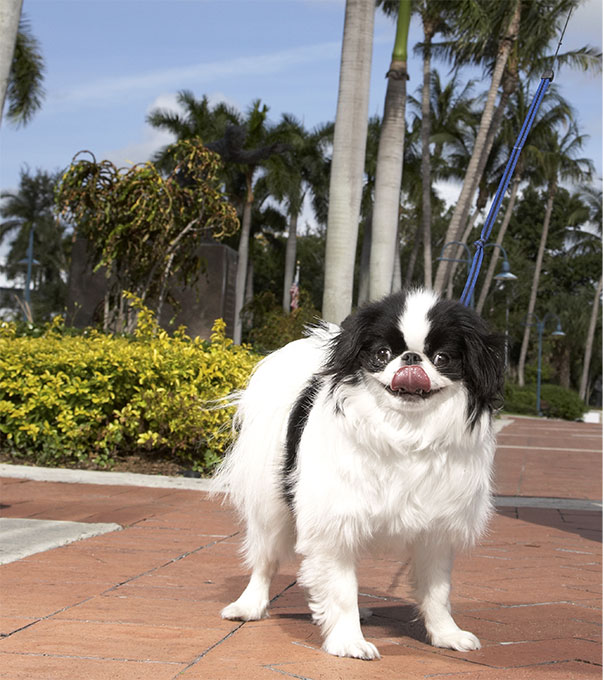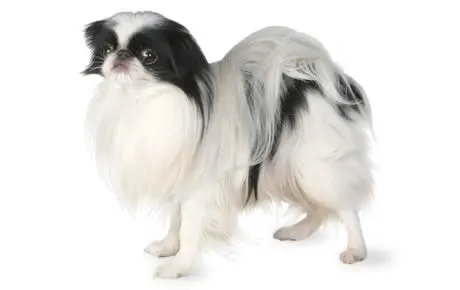The Japanese Chin dog breed hails from Asia, where they’ve been prized as a companion for more than a thousand years. They were a popular member of Chinese and Japanese imperial courts, and it was in Japan that their distinctive look was developed.
Although these are purebred dogs, you may still find them in shelters and rescues. Remember to adopt! Don’t shop if you want to bring a dog home.
This breed is elegant and dainty, mild-mannered and playful. They adapt well to apartment life and even take to novice pet parents with ease; although, they don’t much care for being left alone at home for long hours. These dogs also have a habit of climbing, and you may be surprised when you find your pooch atop the most unusual high places in the home, surveying their domain. Give your Chin plenty of attention and love, and you’ll have an easygoing, adoring cuddle buddy.
See below for complete list of dog breed traits and facts about Japanese Chins!
Japanese Chin Dog Breed Pictures
Adaptability
-
Adapts Well To Apartment Living
Looking for the best dog for your apartment? Contrary to popular belief, the suitability of dogs who adapt well to apartment living goes beyond its size. Apartment dwellers have a myriad of dog breeds to choose from as potential companions, with various factors to consider. Some large breeds can adapt well to apartment living and have lower activity levels. Others may require more space and possess higher energy levels. On the other hand, certain small dog breeds with abundant energy can still find contentment with indoor playtime or brisk walks.
However, when selecting a dog that adapts well apartments, it is essential to prioritize your neighbors. Opting for a pet that doesn’t excessively bark and behaves politely when encountering others in shared spaces like is crucial for maintaining a harmonious apartment environment.
In high-rise settings, it’s worth noting that numerous small dogs may exhibit a propensity for high energy and frequent barking. This makes them less suitable for apartment living. Therefore, desirable qualities in an apartment dog encompass being quiet, low-energy, and displaying polite behavior towards other residents.
Factors To Consider When Choosing A Dog For An Apartment
When considering dogs that adapt well to apartments, size alone should not be the sole determinant. Apartment dwellers have a wealth of dog breeds to choose from as potential furry companions. It’s important to remember that the size of your living space is just one factor to consider. While some larger breeds can adapt well to apartment living, with lower, others may require more space and have higher energy levels, making them less suitable for smaller apartments. Conversely, certain small dog breeds with higher energy levels can still thrive in apartments, finding contentment through indoor playtime or brisk walks. However, it is crucial to consider your neighbors’ comfort when selecting a dog. Opt for a pet that doesn’t bark excessively and behaves politely when interacting with others in shared spaces.
Therefore, it’s important to prioritize qualities such as being quiet, low-energy, calm indoors, and exhibiting good manners when living in close proximity to other residents. By considering these factors, you can find a dog that will adapt well to apartment living and create a harmonious living environment for everyone involved.
-
Good For Novice Owners
Some dogs are simply easier than others; they take to training better and are fairly easygoing. They’re also resilient enough to bounce back from your mistakes or inconsistencies.
Dogs who are highly sensitive, independent thinking, or assertive may be harder for a first-time dog parent to manage. You’ll get your best match if you take your dog-owning experience into account as you choose your new pooch.
If you’re new to dog parenting, take a look at 101 Dog Tricks and read up on how to train your dog!
-
Sensitivity Level
Some dogs will let a stern reprimand roll off their backs, while others take even a dirty look to heart. Low-sensitivity dogs, also called “easygoing,” “tolerant,” “resilient,” and even “thick-skinned,” can better handle a noisy, chaotic household, a louder or more assertive owner, and an inconsistent or variable routine. Do you have young kids, throw lots of dinner parties, play in a garage band, or lead a hectic life? Go with a low-sensitivity dog.
-
Tolerates Being Alone
Some breeds bond very closely with their family and are more prone to worry or even panic when left alone by their owner. An anxious dog can be very destructive–barking, whining, chewing, and otherwise causing mayhem. These breeds do best when a family member is home during the day or if you can take the dog to work.
-
Tolerates Cold Weather
Breeds with very short coats and little or no undercoat or body fat, such as Greyhounds, are vulnerable to the cold. Dogs with a low cold tolerance need to live inside in cool climates and should have a jacket or sweater for chilly walks. You can find a great jacket for your dog here!
-
Tolerates Hot Weather
Dogs with thick, double coats are more vulnerable to overheating. So are breeds with short noses, like Bulldogs or Pugs, since they can’t pant as well to cool themselves off. If you want a heat-sensitive breed, your dog will need to stay indoors with you on warm or humid days, and you’ll need to be extra cautious about exercising your dog in the heat.
All-around friendliness
-
Affectionate With Family
When it comes to unconditional love and unwavering loyalty, few animals can rival the affectionate nature of dogs. These remarkable creatures have earned their reputation as man’s best friend, and many breeds are particularly renowned for their love and devotion to their families. With their warm hearts and wagging tails, affectionate family dogs enrich the lives of their owners in countless ways.
One such breed known for its affectionate demeanor is the Golden Retriever. With their gentle temperament and friendly disposition, Golden Retrievers form deep bonds with their families. They eagerly participate in family activities, whether it’s a game of fetch in the yard or cuddling on the couch during a movie night. Their expressive eyes and ever-wagging tails are a testament to the joy they feel in the presence of their loved ones.
Another family-favorite breed is the Labrador Retriever. Renowned for their playful and patient nature, Labradors are excellent companions for children and adults alike. They readily engage in playtime with the kids, showcasing their boundless energy and enthusiasm. But when the day winds down, they seamlessly transition into loving and gentle cuddle buddies, comforting their family members with their warm presence.
Beyond specific breeds, mixed-breed dogs also have a special place in the hearts of families seeking affectionate companions. The shelter dogs, in particular, form deep connections with their adoptive families. They seem to understand the second chance they’ve been given and repay it with endless love and gratitude.
How To Know If A Dog Is Good With Families
The affectionate nature of family dogs extends beyond play and cuddles. Dogs have a remarkable ability to sense their owner’s emotions, offering comfort and support during difficult times. Whether it’s a wagging tail after a long day at work or a sympathetic nuzzle during moments of sadness, they prove time and again that they are attuned to their family’s needs.
It is important to note that not all dogs of the same breed will be equally affectionate. Some dogs may be more independent or aloof, while others may be more clingy or demanding of attention. The best way to find out how affectionate a dog is is to meet them in person and interact with them.
-
Kid-Friendly
Being gentle with children, sturdy enough to handle the heavy-handed pets and hugs they can dish out, and having a blasé attitude toward running, screaming children are all traits that make a kid-friendly dog. You may be surprised by who’s on that list: Fierce-looking Boxers are considered good with children, as are American Staffordshire Terriers (which are considered Pit Bulls). Small, delicate, and potentially snappy dogs such as Chihuahuas aren’t always so family-friendly.
**All dogs are individuals. Our ratings are generalizations, and they’re not a guarantee of how any breed or individual dog will behave. Dogs from any breed can be good with children based on their past experiences, training on how to get along with kids, and personality. No matter what the breed or breed type, all dogs have strong jaws, sharp pointy teeth, and may bite in stressful circumstances. Young children and dogs of any breed should always be supervised by an adult and never left alone together, period.
-
Dog Friendly
Friendliness toward dogs and friendliness toward humans are two completely different things. Some dogs may attack or try to dominate other dogs, even if they’re love-bugs with people; others would rather play than fight; and some will turn tail and run. Breed isn’t the only factor. Dogs who lived with their littermates and mother until at least six to eight weeks of age and who spent lots of time playing with other dogs during puppyhood, are more likely to have good canine social skills.
-
Friendly Toward Strangers
Stranger-friendly dogs will greet guests with wagging tails and nuzzles; others are shy, indifferent, or even aggressive. However, no matter what the breed, a dog who was socialized and exposed to lots of different types, ages, sizes, and shapes of people as a puppy will respond better to strangers as an adult. Remember that even friendly dogs should stay on a good, strong leash like this one in public!
Health And Grooming Needs
-
Amount Of Shedding
If you’re going to share your home with a dog, you’ll need to deal with some level of dog hair on your clothes and in your house. However, shedding does vary greatly among the breeds. Some dogs shed year-round, some “blow” seasonally, some do both, and some shed hardly at all. If you’re a neatnik, you’ll need to either pick a low-shedding breed or relax your standards. To help keep your home a little cleaner, you can find a great de-shedding tool here!
-
Drooling Potential
Drool-prone dogs may drape ropes of slobber on your arm and leave big, wet spots on your clothes when they come over to say hello. If you’ve got a laid-back attitude toward slobber, fine; but if you’re a neatnik, you may want to choose a dog who rates low in the drool department.
-
Easy To Groom
Some breeds are brush-and-go dogs; others require regular bathing, clipping, and other grooming just to stay clean and healthy. Consider whether you have the time and patience for a dog who needs a lot of grooming, or the money to pay someone else to do it.
-
General Health
Due to poor breeding practices, some breeds are prone to certain genetic health problems, such as hip dysplasia. This doesn’t mean that every dog of that breed will develop those diseases; it just means that they’re at an increased risk.
If you’re adopting a puppy, it’s a good idea to find out which genetic illnesses are common to the breed you’re interested in. You may also want to ask if your shelter or rescue has information about the physical health of your potential pup’s parents and other relatives.
-
Potential For Weight Gain
Some breeds have hearty appetites and tend to put on weight easily. As in humans, being overweight can cause health problems in dogs. If you pick a breed that’s prone to packing on pounds, you’ll need to limit treats, make sure they get enough exercise, and measure out their daily food servings into regular meals rather than leaving food out all the time.
Ask your vet about your dog’s diet and what they recommend for feeding your pooch to keep them at a healthy weight. Weight gain can lead to other health issues or worsen problems like arthritis.
-
Size
Get ready to meet the giants of the doggy world! Large dog breeds aren’t just big balls of fluff, they’re like loving, oversized teddy bears on a mission to steal your heart. Need some convincing? Let’s dive into the awesome benefits of owning one!
First things first, these pooches are a living security system! With their impressive size and thunderous barks, they’ll have any would-be intruder running for the hills. Talk about peace of mind! Plus, who needs an alarm when you’ve got a furry giant protecting your castle?
But that’s not all. Large dog breeds are all about loyalty and devotion. They’ll stick by your side through thick and thin, becoming your most dedicated bestie. Their love knows no bounds! When you have a giant fluffball showing you unconditional love, you’ll feel like the luckiest human on the planet.
Now, let’s talk about their talents. These big fellas are the ultimate working partners. With brains and brawn, they’re up for any challenge. From search and rescue missions to lending a helping paw to those in need, these dogs are superheroes in fur coats. They’ll make you proud every step of the way!
Don’t let their size fool you—these gentle giants have hearts as big as their paws. They’re incredible with kids and other pets, spreading their love like confetti. Their patience and kindness make them perfect family pets, ensuring harmony in your household.
Oh, and get ready to break a sweat! These dogs are fitness enthusiasts, and they’ll keep you on your toes. Daily walks, jogs, and play sessions will not only keep them happy and healthy but will also give you a reason to ditch the couch and join in on the fun. It’s a win-win situation!
So, if you’re ready for a dose of big love, go ahead and consider a large dog breed. They’re the best wing-dog you could ever ask for, ready to make your life a thousand times more exciting, loving, and downright awesome! Get ready for the big adventure of a lifetime!
Trainability
-
Easy To Train
Easy-to-train dogs are more adept at forming an association between a prompt (such as the word “sit”), an action (sitting), and a consequence (getting a treat) very quickly. Other dogs need more time, patience, and repetition during training.
Many breeds are intelligent but approach training with a “What’s in it for me?” attitude, in which case you’ll need to use rewards and games to teach them to want to comply with your requests.
Related:
10 Fun, Impressive Tricks You Can Teach Any Dog
-
Intelligence
Dogs who were bred for jobs that require decision making, intelligence, and concentration, such as herding livestock, need to exercise their brains, just as dogs who were bred to run all day need to exercise their bodies. If they don’t get the mental stimulation they need, they’ll make their own work–usually with projects you won’t like, such as digging and chewing. Obedience training and interactive dog toys are good ways to give a dog a brain workout, as are dog sports and careers, such as agility and search and rescue.
-
Potential For Mouthiness
Common in most breeds during puppyhood and in Retriever breeds at all ages, mouthiness means a tendency to nip, chew, and play-bite (a soft, fairly painless bite that doesn’t puncture the skin). Mouthy dogs are more likely to use their mouths to hold or “herd” their human family members, and they need training to learn that it’s fine to gnaw on chew toys, but not on people. Mouthy breeds tend to really enjoy a game of fetch, as well as a good chew on a toy that’s been stuffed with kibble and treats.
-
Prey Drive
Dogs with a high prey drive have an instinctive desire to stalk, capture, and prey upon potential food sources. Dogs who were bred to hunt, such as Terriers, have an inborn desire to chase — and sometimes kill — other animals. Anything whizzing by — such as cats, squirrels, and perhaps even cars — can trigger that instinct.
How to address a high prey drive
Off-leash adventures are too great a temptation for pups who will wander and hunt. Dogs who like to chase need to be leashed. And, even on a leash, you may experience your dog pulling on the leash to reach rodents or birds in their sight. Otherwise, these pups should be kept in a fenced area when outdoors. If your pup has a high prey drive, you’ll need a high, secure fence in your yard.
These breeds generally aren’t a good fit for homes with smaller pets that can look like prey, such as cats, hamsters, or small dogs. Breeds that were originally used for bird hunting, on the other hand, generally won’t chase, but you’ll probably have a hard time getting their attention when there are birds flying by.
Other behavioral concerns
Observing your dog’s prey drive, which is instinctual and biologically-rooted, is not the same as observing aggression. Much aggression is born of fear and anxiety, especially in the case of dog aggression toward humans.
The tendency to wander, even into oncoming traffic, can produce diasterious results for pups with predatory instincts. It can also lead to pups being bitten by snakes or attacked by other wild animals they may pursue while on the hunt.
-
Tendency To Bark Or Howl
Some breeds sound off more often than others. When choosing a breed, think about how often the dog vocalizes. Learn more about breeds with a tendency to bark or howl.
If you’re considering a hound, would you find their trademark howls musical or maddening? If you’re considering a watchdog, will a city full of suspicious “strangers” put your pup on permanent alert? Will the local wildlife literally drive your dog wild? Do you live in housing with noise restrictions? Do you have neighbors nearby? Then you may wish to choose a quieter dog.
-
Wanderlust Potential
Some breeds are more free-spirited than others. Nordic dogs such as Siberian Huskies were bred to range long distances, and given the chance, they’ll take off after anything that catches their interest. And many hounds simply must follow their noses–or that bunny that just ran across the path–even if it means leaving you behind.
Exercise needs
-
Energy Level
High-energy dogs are always ready and waiting for action. Originally bred to perform a canine job of some sort, such as retrieving game for hunters or herding livestock, they have the stamina to put in a full workday. They need a significant amount of exercise and mental stimulation, and they’re more likely to spend time jumping, playing, and investigating any new sights and smells.
Low-energy dogs are the canine equivalent of a couch potato, content to doze the day away. When picking a breed, consider your own activity level and lifestyle, and think about whether you’ll find a frisky, energetic dog invigorating or annoying.
-
Intensity
A vigorous dog may or may not have high energy, but everything they do, they do with vigor: they strain on the leash (until you train them not to), try to plow through obstacles, and even eats and drinks with great big gulps. These dynamos need lots of training to learn good manners, and may not be the best fit for a home with young kids or someone who’s elderly or frail. A low-vigor dog, on the other hand, has a more subdued approach to life.
-
Exercise Needs
Some breeds do fine with a slow evening stroll around the block. Others need daily, vigorous exercise, especially those that were originally bred for physically demanding jobs, like herding or hunting.
Without enough exercise, these breeds may put on weight and vent their pent-up energy in ways you don’t like, such as barking, chewing, and digging. Breeds that need a lot of exercise are good for outdoorsy, active people, or those interested in training their dog to compete in a high-energy dog sport, such as agility.
-
Potential For Playfulness
Some dogs are perpetual puppies — always begging for a game — while others are more serious and sedate. Although a playful pup sounds endearing, consider how many games of fetch or tag you want to play each day, and whether you have kids or other dogs who can stand in as playmates for the dog.
Japanese Chin Overview
Jumpin’ jiminy! Is that a Japanese Chin on your fireplace mantel? It is! People who live with the Chin often marvel at the breed’s ability to leap tall furniture in a single bound. The toy-size Japanese Chin has a catlike nature that includes the desire to be in high places, the ability to climb, and the tendency to wash himself. He has also been seen batting at objects much like a cat would.
Feline traits notwithstanding, the Japanese Chin has all of the qualities one looks for in a companion dog. He thrives when he’s with his people, and he loves everyone. Japanese Chin do well in apartments and will adapt to any living situation, but their tiny size and love of human companionship mean they’re not suited to living outdoors or in a kennel.
Japanese Chin have the classic look of an Oriental breed with a large, broad head; large, wide-set eyes; and a flattish face. Small, V-shaped ears hang down, set just below the top of the head. They carry their plumed tail jauntily over their back.
They have an abundant coat, but looks are deceiving. The Chin is a wash-and-go breed and needs little more than a weekly brushing to maintain his elegant appearance. With the occasional exception of the ear fringes, the coat rarely mats, and it doesn’t require any trimming.
Intelligent and well mannered, the Japanese Chin learns quickly, but he has a mind of his own. If training becomes repetitive, he will choose to do something more entertaining. He can be difficult to housetrain, but if you’re persistent and consistent he’ll get the message.
In general, the Japanese Chin is a happy dog who gets along with everyone. He’s friendly toward other dogs and cats and is a playful companion for older children. Because of his small size, however, he’s not suited to homes with young children, who might accidentally injure him. Chin are loving and devoted to their family, but they have a natural shyness around new people and new situations. It’s not unusual for them to be slightly aloof with strangers until they get to know them.
The Japanese Chin requires little in the way of exercise and is a great companion to people who can’t get around easily. He enjoys a daily walk or play session but won’t become destructive if you just lie around eating bonbons and playing with him. Chin enjoy playing, and they move with such grace and agility that they rarely disturb anything when they race through a home.
These are sensitive dogs. They pick up on the emotions of the home and their owners and will shape their personality to match. If he lives in a home that is quiet and somber, the Japanese Chin will become quiet and reserved, yet still possess all the wonderful traits of a companion dog. If he lives in an active home, he will generally be lively and outgoing.
Fun-loving and charming, the Chin can be addictive. People who love him can’t imagine life without him, and many can’t imagine life without two or three.
Japanese Chin Highlights
- The Japanese Chin is catlike in many ways. The breed is commonly seen grooming itself by licking its paws and wiping its head. Also, they enjoy being up high and will perch on the back of couches and on tables.
- Considered to be an average shedder, the Japanese Chin requires a few minutes of brushing each day to remove loose hair and to keep the coat from tangling.
- Japanese Chin do not handle heat very well and need to be monitored on hot days to ensure that they don’t overexert themselves.
- Due to the breed’s flat face, Japanese Chin will often snort, sniffle, or reverse sneeze. Generally, a Japanese Chin is still able to breathe through this, but if the attack becomes severe, you can try gently stroke his neck.
- Japanese Chin do well in apartments.
- Although Japanese Chin are intelligent and eager to please, they require interesting, fun-filled training sessions. Otherwise, they get bored and will turn their attention to something more entertaining.
- Japanese Chin do very well with older children but are not recommended for homes with smaller children due to their small size. They can be seriously injured with minimal force.
- Japanese Chin are companion dogs who thrive when they are with the people they love. They should not live outside or in a kennel away from their family.
- Japanese Chin require a lower amount of exercise compared to other breeds but they do enjoy a daily walk or play in the yard.
- Japanese Chin don’t like being parted from their people, and separation anxiety is a common problem in the breed.
- To get a healthy dog, never buy a puppy from an irresponsible breeder, puppy mill, or pet store. Look for a reputable breeder who tests her breeding dogs to make sure they’re free of genetic diseases that they might pass onto the puppies, and that they have sound temperaments.
Japanese Chin History
The Japanese Chin is an ancient breed that probably originated in the Chinese imperial court. Highly prized, he was often given as a gift to emissaries from other lands, and it was probably as a gift to the emperor of Japan that he made his way to that island nation which gave him his name. In Japan, the Chin was regarded not as a dog (inu) but as a separate being (chin). There, he was probably crossed with small spaniel-type dogs and eventually achieved the look he has today.
The Japanese Chin remained unknown to the outside world until 1853 when Commodore Matthew Perry sailed into Uraga Harbor near Edo — now modern-day Tokyo — and introduced Japan to international trade. The Japanese Chin became a popular commodity and many were imported into Britain and the United States.
Among the first American owners of the breed were President Franklin Pierce, then-Secretary-of-War Jefferson Davis, and Perry’s daughter, Caroline Perry Belmont. They became popular with people of wealth and nobility. In the United States, the Japanese Chin was known as the Japanese Spaniel and he kept that name until 1977.
Japanese Chin Size
The Japanese Chin is sturdily built but with a refined appearance. He stands 8 to 11 inches at the shoulder and weighs between 4 and 9 pounds.
Japanese Chin Personality
The personality of the Japanese Chin is a true indicator of the depth that these dogs possess. In general, he’s a happy and charming dog who is affectionate and intelligent. He’s talkative, but not barky. Chin people say their dogs like to “sing” and will chatter to announce the arrival of guests or strangers.
Chin are so sensitive to their environments and the emotions of their people that they have been known to shape their personality around them. If he lives in a home that is quiet and somber, the Japanese Chin will become reserved. If he lives in an active home, he will do his part to keep the action lively.
The Japanese Chin is always devoted to his people and may suffer from separation anxiety. He is a pleasant dog who shows love and affection to everyone in his life, but he can be shy when exposed to new people or situations.
Japanese Chin Health
Chin are generally healthy, but like all breeds, they’re prone to certain health conditions. Not all Chin will get any or all of these diseases, but it’s important to be aware of them if you’re considering this breed.
If you’re buying a puppy, find a good breeder who will show you health clearances for both your puppy’s parents. Health clearances prove that a dog has been tested for and cleared of a particular condition. In Chin, you should expect to see health clearances from the Orthopedic Foundation for Animals (OFA) for hip dysplasia (with a score of fair or better), elbow dysplasia, hypothyroidism, and von Willebrand’s disease; from Auburn University for thrombopathia; and from the Canine Eye Registry Foundation (CERF) certifying that eyes are normal. You can confirm health clearances by checking the OFA web site (offa.org).
- Atrioventricular Endocardiosis: This degenerative disease affects the mitral and tricuspid valves of the heart. It occurs when polysaccharide deposits distort the shape of the valves and cause them to leak. This can lead to heart failure. A change in diet and exercise may be necessary.
- Progressive Retinal Atrophy (PRA): A degenerative eye disorder that eventually causes blindness. Blindness caused by PRA is a slow process resulting from the loss of photoreceptors at the back of the eye. PRA is detectable years before the dog shows any signs of blindness. A reputable breeder will have dogs’ eyes certified annually by a veterinary ophthalmologist.
- Patellar Luxation: Also known as “slipped stifles,” this is a common problem in small dogs. It is caused when the patella, which has three parts — the femur (thigh bone), patella (knee cap), and tibia (calf) — is not properly lined up. This causes a lameness in the leg or an abnormal gait in the dog. It is a disease that is present at birth although the actual misalignment or luxation does not always occur until much later. The rubbing caused by patellar luxation can lead to arthritis, which is a degenerative joint disease. There are four grades of patellar luxation, ranging from grade I, which is an occasional luxation causing temporary lameness in the joint, to grade IV, in which the turning of the tibia is severe and the patella cannot be realigned manually. This gives the dog a bowlegged appearance. Severe grades of patellar luxation may require surgical repair.
- Heart Murmurs: Heart murmurs are caused by a disturbance in the blood flow through the chambers of the heart. They’re an indicator that there may be a disease or condition of the heart that will need to be monitored and treated. Heart murmurs are graded on their loudness, with one being very soft and five being very loud. If disease is evident, as diagnosed through x-rays and an echocardiogram, the dog may require medication, a special diet, and a reduction in the amount of exercise he gets.
- Legg-Calve-Perthes Disease: This is another disease involving the hip joint. Many toy breeds are prone to this condition. When your Japanese Chin has Legg-Perthes, the blood supply to the head of the femur (the large rear leg bone) is decreased, and the head of the femur that connects to the pelvis begins to disintegrate. Usually, the first signs of Legg-Perthes, limping and atrophy of the leg muscle, occur when puppies are 4 to 6 months old. The condition can be corrected with surgery to cut off the diseased femur so that it isn’t attached to the pelvis any longer. The scar tissue that results from the surgery creates a false joint and the puppy is usually pain free.
- Cataracts: A cataract is an opacity on the lens of the eye, which causes difficulty in seeing. The eye(s) of the dog will have a cloudy appearance. Cataracts usually occur with old age and can be treated by surgically removing the cataract.
Japanese Chin Care
Japanese Chin require very little exercise. They are happy with a daily walk or a nice play session but they tend to require little else. Training can be slightly difficult since they have a mind of their own and become bored with repetitious training. When they like you, however, they’ll work hard to please you. When they do wrong, a firm tone of voice is all you need to set them straight. Stronger corrections will only backfire and cause your Chin to stubbornly stand his ground.
They can be difficult to housetrain but with patience and consistency, you can generally expect them to be housetrained by 4 months of age.
Japanese Chin are companion dogs and should not live outdoors or in kennels. They become very attached to their people, and many suffer from separation anxiety. With their low exercise needs, Japanese Chin make wonderful apartment residents.
The neck of the Japanese Chin is very delicate and it is strongly suggested that you use a harness instead of a collar when walking him.
Japanese Chin Feeding
Recommended daily amount: 1/4 to 1/2 cup of high-quality dry food a day, divided into two meals.
It is important when you are feeding your Japanese Chin that use choose a food that is high in fiber. Japanese Chin can suffer from impacted anal glands when their diet lacks good dietary fiber.
NOTE: How much your adult dog eats depends on his size, age, build, metabolism, and activity level. Dogs are individuals, just like people, and they don’t all need the same amount of food. It almost goes without saying that a highly active dog will need more than a couch potato dog. The quality of dog food you buy also makes a difference — the better the dog food, the further it will go toward nourishing your dog and the less of it you’ll need to shake into your dog’s bowl.
For more on feeding your Chin, see our guidelines for buying the right food, feeding your puppy, and feeding your adult dog.
Japanese Chin Coat Color And Grooming
The Japanese Chin has an abundant coat that’s silky to the touch. It’s moderately long with a thick mane, feathered ears, a plumed tail, feathering on the back of the front legs, and light feathering that resembles culottes on the rear legs. The head, face, and forelegs are covered with short hair. Japanese Chin can have coats that are black and white, red and white, or black and white with tan points.
Japanese Chin are a very clean breed and do not require regular baths. Once a month is plenty. Dry shampoos will generally keep them looking and smelling great. You can also use a mild shampoo, towel them until they’re almost dry, brush the coat upward and outward with a pin brush, and voila! They’re good to go. Chin do shed, but weekly brushing will help keep the hair from flying around your house. A quick daily brushing with a pin brush will help keep hair from tangling.
Brush your Japanese Chin’s teeth at least two or three times a week to remove tartar buildup and the bacteria that lurk inside it. Daily brushing is even better if you want to prevent gum disease and bad breath.
Trim his nails once or twice a month if your dog doesn’t wear them down naturally to prevent painful tears and other problems. If you can hear them clicking on the floor, they’re too long. Dog toenails have blood vessels in them, and if you cut too far you can cause bleeding — and your dog may not cooperate the next time he sees the nail clippers come out. So, if you’re not experienced trimming dog nails, ask a vet or groomer for pointers.
His ears should be checked weekly for redness or a bad odor, which can indicate an infection. When you check your dog’s ears, wipe them out with a cotton ball dampened with gentle, pH-balanced ear cleaner to help prevent infections. Don’t insert anything into the ear canal; just clean the outer ear.
Begin accustoming your Japanese Chin to being brushed and examined when he’s a puppy. Handle his paws frequently — dogs are touchy about their feet — and look inside his mouth. Make grooming a positive experience filled with praise and rewards, and you’ll lay the groundwork for easy veterinary exams and other handling when he’s an adult.
As you groom, check for sores, rashes, or signs of infection such as redness, tenderness, or inflammation on the skin, in the nose, mouth, and eyes, and on the feet. Eyes should be clear, with no redness or discharge. Your careful weekly exam will help you spot potential health problems early.
Japanese Chin Children And Other Pets
Although the Japanese Chin is a gentle dog, he is not recommended for homes where there are young children. He can be easily hurt by an overexuberant child. The breed does well with older children who understand how to properly handle a dog.
As with every breed, you should always teach children how to approach and touch dogs, and always supervise any interactions between dogs and young children to prevent any biting or ear or tail pulling on the part of either party. Teach your child never to approach any dog while he’s eating or sleeping or to try to take the dog’s food away. No dog, no matter how friendly, should ever be left unsupervised with a child.
Japanese Chin get along well with other dogs and cats, but they must be protected from larger dogs who could accidentally injure them in play. A cat’s claws can injure their large eyes, so it’s important to make sure everyone plays nicely together.
Japanese Chin Rescue Groups
Chin are often purchased without any clear understanding of what goes into owning one. There are many Chin in need of adoption and or fostering. There are a number of rescues that we have not listed. If you don’t see a rescue listed for your area, contact the national breed club or a local breed club and they can point you toward a Chin rescue.
Japanese Chin Dog Breed Pictures
-
Japanese Chin Dog Breed Picture
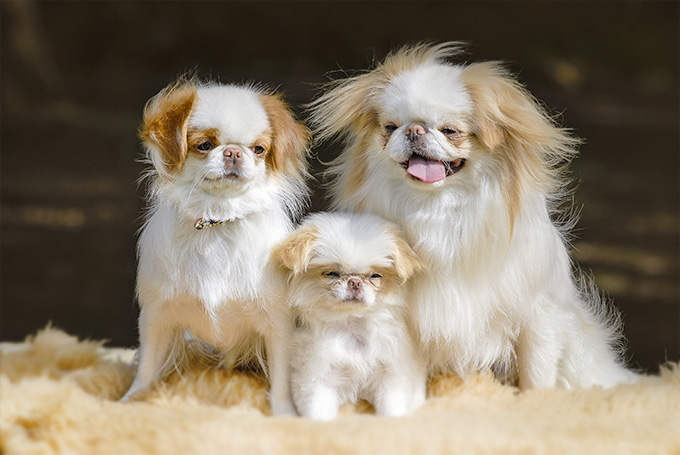
-
Japanese Chin Dog Breed Picture

-
Japanese Chin Dog Breed Picture
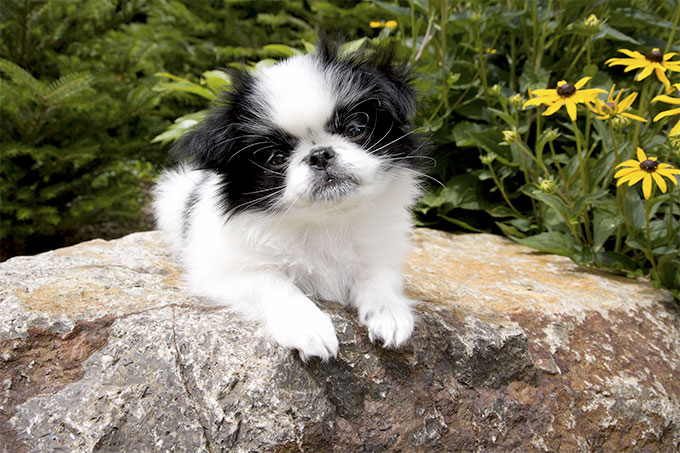
-
Japanese Chin Dog Breed Picture
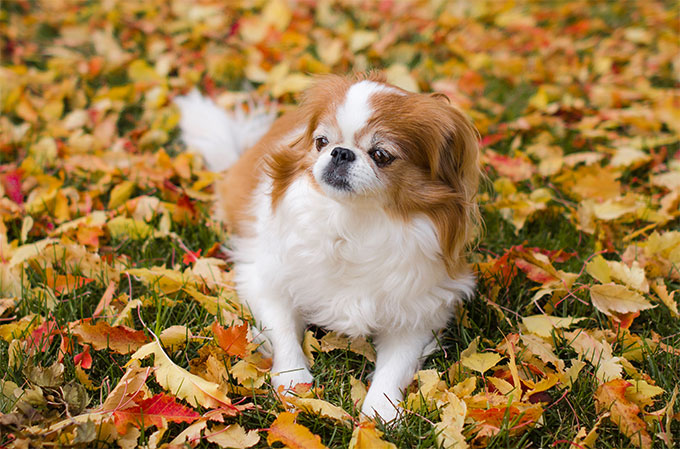
-
Japanese Chin Dog Breed Picture

-
Japanese Chin Dog Breed Picture
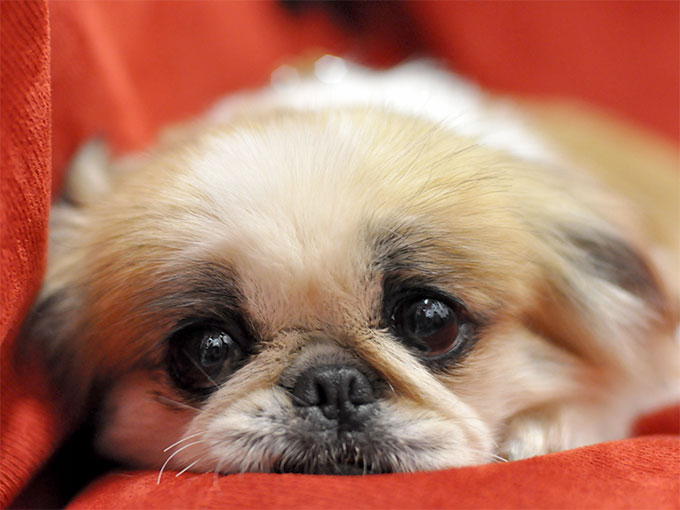
-
Japanese Chin Dog Breed Picture
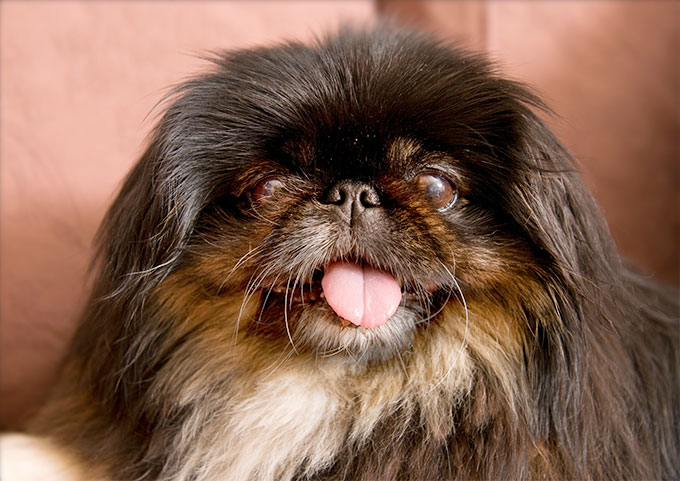
-
Japanese Chin Dog Breed Picture
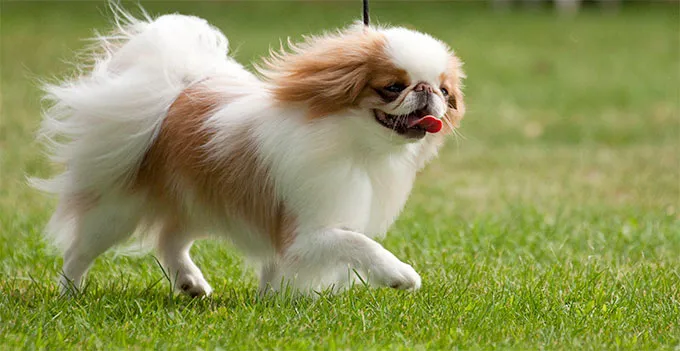
-
Japanese Chin Dog Breed Picture
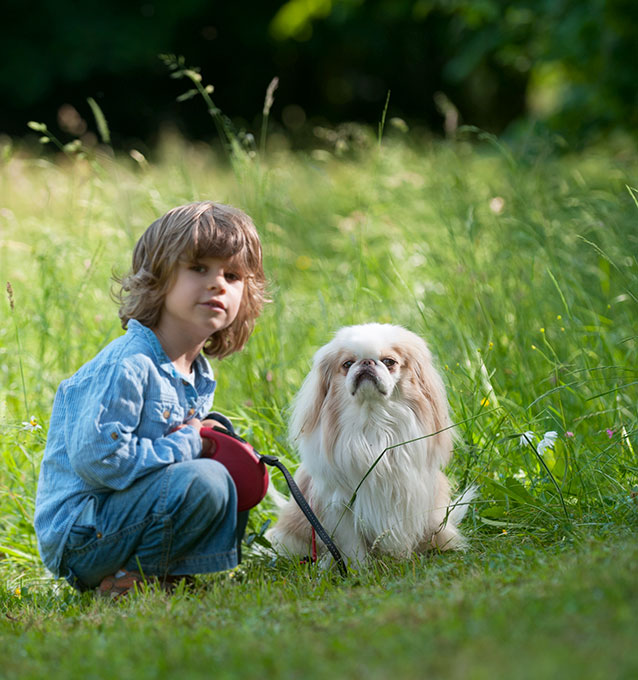
-
Japanese Chin Dog Breed Picture
